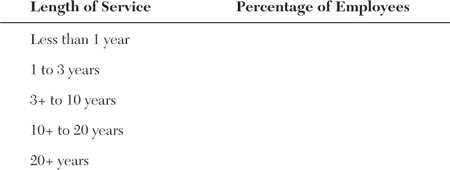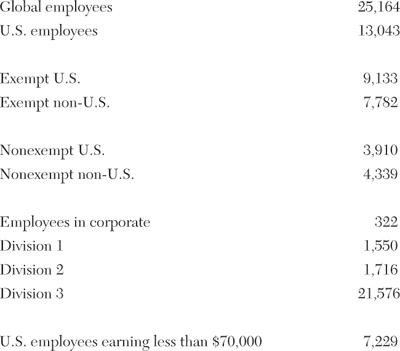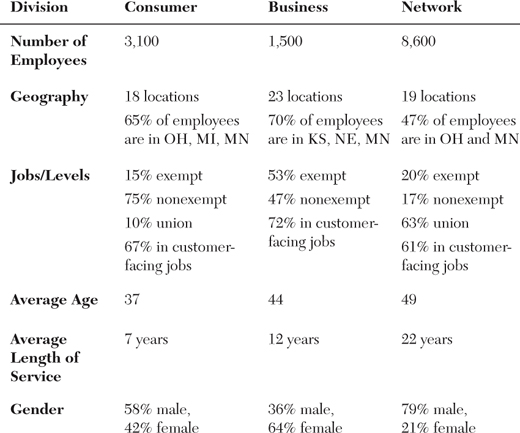1. Know Your Employees
If you were to enroll in a college course on marketing, the very first rule you’d learn is this: “Know your audience.” That’s because the most effective way to reach people—and to motivate them to take action—is to understand who they are and what they need.
This may sound basic, but assessing employees is a step that’s often skipped in HR communication. We plunge into creating communication without thinking about the people we’re creating it for. Even worse, we assume that employees are just like us, taking for granted that the ways we like communicating will work equally well for employees in a variety of jobs, geographies, and functions.
Like many assumptions, this one is dangerous. It leads to these kinds of communication mistakes:
• Using terms such as “competencies” and “salary structure” that make perfect sense to HR experts but that mean nothing to employees.
• Telling the entire history of how a program was developed, when employees just want to know what’s changed and what they need to do about it.
• Failing to make connections or put topics in context. You know that “compensation” consists of different elements such as base pay, bonuses, and stock options, but employees may not understand that the individual pieces add up to something called “compensation.”
How can you make sure you truly know your employee audience? We recommend that you start by analyzing your employee demographics and then conducting qualitative research—such as focus groups—to explore communication needs and preferences. This chapter shows you how.
What Demographics Can Reveal About Employees
Back when we started our careers (a long, long time ago), the subject of demographics rarely came up, mostly because there was very little to talk about. After all, the employees at most U.S. companies were mostly homogenous: mostly male, mostly white, mostly all from the same region, with similar backgrounds, accents, values, and aspirations.
Obviously, the workforce has changed. For example, in the United States, the newest generation entering the employment market, the Millennials (born between 1980 and 2000), represents a much more diverse group than the previous two generations. Some 40% of Millennials are black, Latino, or Asian, compared with a total of 25% in both of the previous two generations (Generation X and the baby boomers).
This is just one reason why it’s become so crucial to conduct an analysis of your workforce demographics periodically.
dem-o-graph-ics
The characteristics of human populations and population segments, especially when used to identify consumer markets: The demographics of the Southwest indicate a growing population of older consumers.
—Houghton Mifflin dictionary
What You Can Learn from Demographics
Demographics offer a way to distinguish and describe characteristics of a population to determine what sets that segment apart. Although not a foolproof predictor, demographics are so valuable that it’s surprising that HR professionals don’t always have employee information at their fingertips. Everyone typically knows how many employees work at their company, but you also need to know other important facts about your employees:
Key employee demographics:
• Where are your employees located?
• What is the average length of employee service?
• How are your employees divided in terms of age? Male/female ratio? Ethnic mix? Educational level?
• What is the median salary for all employees? What are the salary ranges for different job families, businesses, and locations?
• How many employees fall into each pay/job grade or job/functional category?
• Which primary languages do your employees speak? For what percentage of your employee audience is English a second language?
• How many employees support dependents? On average, how many dependents do they have?
• How many employees have computers at work, easy access to the company intranet, and e-mail accounts?
• Can employees take time at work to attend meetings about HR programs, services, and products? Do meetings need to be held before or after work or at lunchtime? Do employees need to be paid overtime to attend these meetings?
• What percentage of your employee population belongs to a union? How many unions are represented at your workplace?
• How many employees are also customers of your company? How many are also shareholders in your company?
Your employee demographics will give you valuable insights into almost every aspect of communication, especially the following:
• What to communicate (content) and what examples will resonate with your audience.
• How to communicate (for example, print, electronic, or face-to-face).
• When and where to communicate.
For example, your company’s medical plan enrollments will show you what percentage of your population has children. This is important to know when you’re communicating about many topics, such as medical benefits, life insurance, savings, time off, and flexible work arrangements. Understanding how many employees have families also helps you know when to communicate. For example, meetings before or after work may be difficult for some employees to attend.
Four Key Demographics to Explore
Are you ready to take a closer look at your company’s employee demographics? Since most of us have limited time and budgets, we can’t consider every detail. But you should think about four critical categories: geography, years of service, age, and salary.
Geography
Even in this age where electronic communication breaks down boundaries, geography still matters. Where a person lives and works rates as an important part of his or her identity.
Gather the following demographic data on geography:
• Your organization’s geographic scope: Pinpoint all the locations on a map of the country or the globe, and see how your organization is distributed.
• The number of employees who work at headquarters and other major locations.
• Remote locations: how many employees work at small facilities.
• Field employees (such as sales representatives), work-from-home employees, and client-located employees.
Years of Service
How long employees stay with an organization has both practical and cultural implications. A stable employee population has a long memory, which can be a positive (strong company heritage) or a negative (still seething over something that happened years ago). By contrast, if turnover is high, employees need to ramp up quickly on procedures and culture, and this information needs to be refreshed frequently.
Gather the following demographic data on tenure:

Age
Here’s a demographic term for you: “generational cohort.” This is “the aggregation of individuals who experience the same event within the same time interval.” Sociologists and marketers use terms such as “baby boomers” and “Gen Xers” to describe groups of people bound together by broad shared experience.
This is important for two reasons:
1. Our attitudes are informed by how old we are and by the generation in which we grew up, including the movies we saw, the music we listened to, and the world events we witnessed.
2. How people experience communication continues to be influenced by age.
For example, many baby boomers who remember where they were when President Kennedy was shot vividly recall all those workdays before computers and e-mail (the days of the printed memo). Many still aren’t completely comfortable with the latest in technology. Workers younger than 40 grew up using technology, and most master new channels with ease.
Gather the following demographic data on age:

Salary
Along with geography, age, and years of service, salary also ranks as an important demographic, especially when you’re communicating about any financially based plans, such as savings plans, retirement plans, or stock purchase plans.
You’ll want to show examples of how these plans would work for people earning at various salary levels. It’s a good rule of thumb to show examples beginning with a number less than the low end of your company’s salary ranges and then include numbers that can easily be multiplied for your top earners. There’s no need to reinforce pay differences between lower-level workers and executives. You should show how everyone, no matter what his or her salary is, can participate in savings and other financial plans.
Gather the following demographic data on salary:
• Percentage of workers paid by the hour. Depending on your company, you may have different levels of hourly workers. For example, retail employees are often paid near minimum wage, so their pay is much lower than experienced hourly workers at a unionized manufacturing plant.
• Percentage of exempt salaried workers.
• Employees in various nonexempt bands, from new hires to executives.
Use Focus Groups to Explore Needs and Preferences
As you can tell, we’re big fans of demographics, agreeing with David Foot that they explain “two-thirds of everything.” But to really get inside the minds of employees, you need to go further and talk to them. The best way to do so is to conduct focus groups.
Why focus groups? This proven research method—widely practiced by marketers, scientists, and other professionals since the 1920s—can help you do the following:
• Explore an issue.
• Test a concept.
• Follow up on the launch of a program to see how well it was understood or received.
• Find out why employees answered a survey in a certain way.
Focus groups are a form of qualitative research that explores an issue in depth, allowing people to express their opinions and engage in dialog. Unlike quantitative research (such as surveys), qualitative research does not provide statistical data. Yet qualitative research is considered a scientifically valid tool that yields valuable insights into what people perceive and believe.
In addition to focus groups, types of qualitative research include one-on-one interviews (often used when the topic is personal or sensitive, or when it’s logistically difficult to bring people together) and user testing (observing a person while he or she completes a task, such as visiting a website or completing a form).
Focus groups are ideal when you need to explore a topic in an open-ended way, since you can dive deeper and ask follow-up questions. If you need to ask, “Why is this true?” or “What does this mean?”, focus groups are the right research method.
Although focus groups can seem deceptively simple to manage—“All you need to do is gather employees in a conference room and start talking, right?”—experts know that this research method is more complicated than meets the eye. That’s why HR professionals often turn to research firms or external moderators to assist with focus group studies.
Guidelines for Conducting Focus Groups
If you decide to manage your own focus groups, several good books provide how-to information:
The Focus Group Kit by David L. Morgan and Richard A. Krueger (Sage Publications, 1997)
How to Conduct Employee Focus Groups by Joe DeLuccia, Kimberly Gavagan, and David Pitre (Davis & Company, 2009)
Moderating Focus Groups: A Practical Guide for Group Facilitation by Dr. Thomas L. Greenbaum (Sage Publications, 1999)
We can’t give you a complete recipe for conducting focus groups. But we believe three factors will help you plan a focus group study: set objectives, develop a discussion guide, and choose participants.
Set Objectives
Your first step is to set objectives, which articulate—in a disciplined, focused way—what you’re trying to learn as a result of your focus group research. Objectives provide a framework to answer the question: What am I willing and able to change as a result of this research?
Setting objectives begins with creating a thesis, a statement that summarizes what you’re trying to accomplish.
The thesis can be expressed as statement (“Employees seem to be just going through the motions in the performance management system, instead of participating fully.”) or as a question (“How will employees react to the new retirement program?”). In either case, the thesis articulates the core reason you’re engaging in focus groups.
After you’ve nailed down the thesis, use it to create no more than three objectives.
Develop a Discussion Guide
As soon as your objectives are set, you’re ready to develop a discussion guide, which is the term used by researchers to describe the document—part script, part outline—that the focus group moderator uses to facilitate the session.
To create a discussion guide, think about the two or three main things you want to learn. For example, if your thesis involves finding out what employees think about a change to disability plans, you could explore these categories:
• Employees’ understanding of the current plans
• Their reaction to planned changes
• How they would like to learn about changes
Once you have your main categories, think about the key questions for each category that will help your moderator discuss the issue with participants. Avoid the temptation to create a long list of questions. The idea is to give the moderator a sense of structure, not to script every word he or she will say.
Sample Discussion Guide
The following is an example of a simple discussion guide used in a one-hour focus group designed to explore how employees were perceiving the current HR program.
Study Objectives:
Inquire about HR communication needs and preferences, find out how employees are using the HR website, and get employee reaction to recent communication regarding the new benefits plan.
Discussion Outline:
A. Introduction/manage expectations
• Explain why the focus group is being held, along with ground rules for participation and what to expect.
B. HR information needs and preferences
• How do you currently get information about benefits and other HR programs and policies?
• Do you feel well-informed about your benefits?
• What would you like more information about?
C. Use of HR website
• Do you currently use the company’s HR website?
• What do you use it for?
• Do you find the information useful?
• What, if anything, would you change about the site?
D. Reaction to recent HR communication
• Did you receive the recent message from HR about the new medical plan?
• What was your reaction to the message?
• How did it make you feel?
• What, if anything, would you change about similar messages in the future?
E. Close
• Thank you/next steps.
Choose Participants
Most focus studies involve a limited number of participants. For example, even a large study might engage fewer than 100 people from an overall workforce of 10,000 employees. Because the sample is so small, it’s critical to be smart about how participants are selected and to work hard to encourage selected employees to participate.
The best way to select participants is to use a method called “purposively selected” sampling. This consists of deciding on your criteria and then finding people who meet these criteria. This is different from the random sampling used for surveys, and it’s a far cry from the casual way in which focus groups are often put together—inviting only people you know.
For example, if your thesis is “How do employees regard the current benefits program?”, your sample would be benefits-eligible employees. You then can decide if you’d like to segment subgroups. When Alison’s firm conducted focus groups to gather feedback on an executive pay program, the sample was all executives, but participants were grouped by level: junior and intermediate executives into one set of focus groups, and senior executives into another.
Guidance on Selecting Participants
Using your demographic data as a foundation, answer these questions to jump-start your thinking about who should participate:
• How is your employee population structured? What are the main demographic groups? Do you need to segregate various sets of employees (manager/nonmanager, bands/levels, or new employees versus long-timers)?
• Where are your major locations? Should your sample reflect important differences between locations? For instance, do you have large facilities and small ones, locations in the United States and in other countries, warehouses versus retail establishments?
• What groups will your company management expect to see represented in order for them to feel comfortable about what you learn in the focus groups? Asking this question can potentially direct you to include a small but important employee group in your research.
First decide on criteria, and then find people who meet those criteria.
Checklist for Knowing Your Employees
![]() Consider who’s in your employee audience before beginning any communication program.
Consider who’s in your employee audience before beginning any communication program.
![]() Gather data on where your employees work to understand their geographic demographics.
Gather data on where your employees work to understand their geographic demographics.
![]() Use data about length of service to influence the depth of information you provide.
Use data about length of service to influence the depth of information you provide.
![]() Understand how “generational cohorts” shape how employees think, behave, and prefer to receive communication.
Understand how “generational cohorts” shape how employees think, behave, and prefer to receive communication.
![]() Compile salary data to inform communication, especially about pay, savings, retirement, stock, and other financially based programs.
Compile salary data to inform communication, especially about pay, savings, retirement, stock, and other financially based programs.
![]() Use focus groups or other qualitative research methods to explore employee attitudes, experiences, and preferences.
Use focus groups or other qualitative research methods to explore employee attitudes, experiences, and preferences.
![]() Before conducting focus groups, be clear on the objectives of your research to ensure that your study is structured to achieve those objectives.
Before conducting focus groups, be clear on the objectives of your research to ensure that your study is structured to achieve those objectives.


